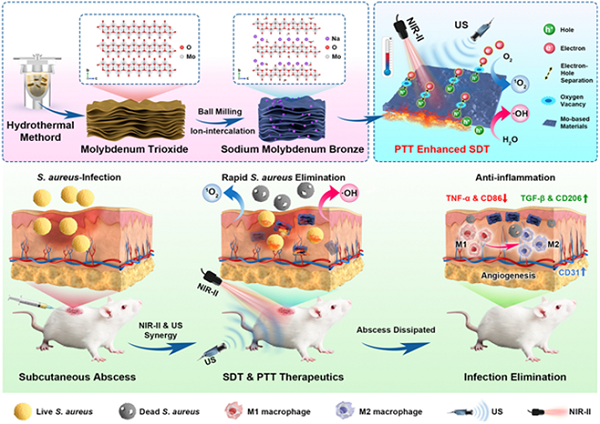- Newsroom
- Research Progress
- Academic Events
- Join Us
Defective molybdenum-based nanoplatform modulates NIR-II enhance sonodynamic for anti-infective therapy
2022-07-20
Recently, Prof. Jianliang Shen and Jong Seung Kim academician have developed a defective molybdenum-based nanoplatform (SMB NPs). Ultrasound (US)-mediated sonodynamic therapy (SDT) has the advantages of non-invasiveness and deep tissue penetration. How to improve the efficiency of SDT is a key issue at present. In this study, the high photothermal conversion efficiency of SMB NPs in the near-infrared second region (NIR-II) is controlled by the rich oxygen vacancy structure, and the electron-hole separation speed can be effectively improved, thereby improving the SDT efficiency. Notably, this nanoplatform can utilize NIR-II-enhanced SDT to achieve efficient antibacterial and anti-biofilm activities, and be used for efficient deep-seated tissue infection therapy to accelerate infected tissue repair. The study was published in Advanced Functional Materials (IF: 19.924) with the title "NIR-II Photo-Amplified Sonodynamic Therapy Using Sodium Molybdenum Bronze Nanoplatform Against Subcutaneous Staphylococcus Aureus Infection". This study demonstrates for the first time a newly developed molybdenum-based sonosensitizer that exhibits excellent anti-infective therapeutic properties via SDT therapy that facilitates hyperthermia.

Figure 1. Defective Mo-based nanoplatforms for anti-infective therapy via NIR-II-enhanced SDT
The corresponding authors of the paper are Jianliang Shen Researcher and Jong Seung Kim Academician, the first author of the paper Xiaojun He, Ji-Ting Hou Associate Researcher and Xiaoshuai Sun postgraduate; the paper was awarded the National Natural Science Foundation of China (21977081) and the Research Institute Start-up Special (WIBEZD2017001-03), etc. heavily funded.